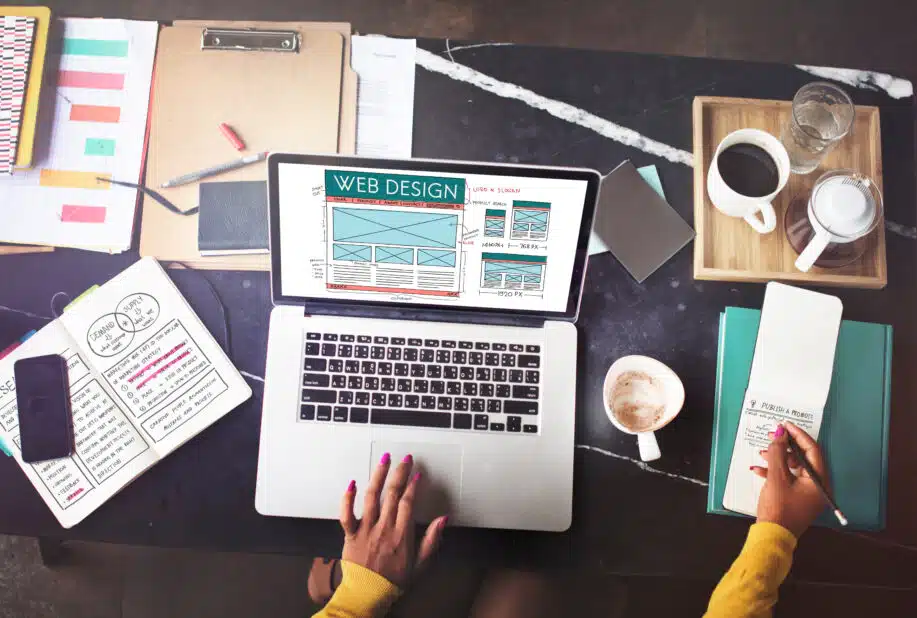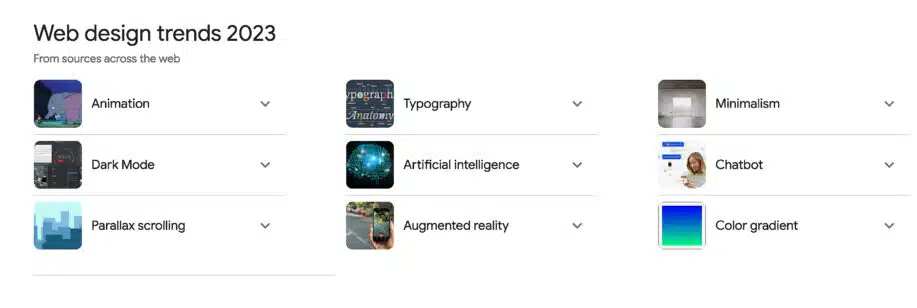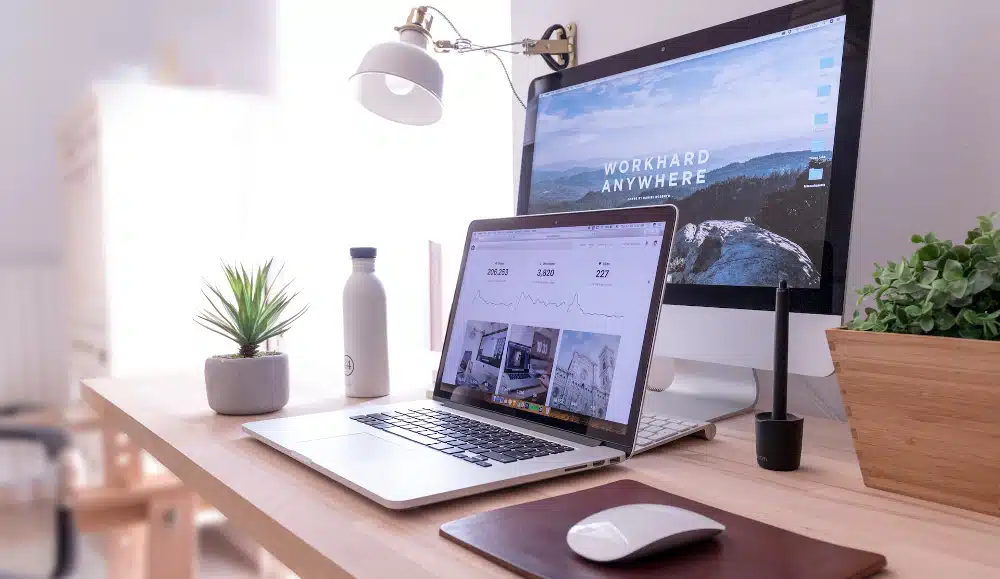As we work our way through 2023, the world of web design continues to evolve with new and exciting trends. With a focus on enhancing the user experience, web designers prioritize functionality and aesthetics to create engaging and memorable websites.
The trend for 2023 includes a move towards more of the same as well as new elements too, such as minimalist designs with an emphasis on typography and bold colors.
You can expect to see more websites adopting dark mode and incorporating animated illustrations and 3D elements. Mobile responsiveness remains a top priority as more and more users access the internet on their mobile devices. Overall, the website trends for 2023 aim to create seamless and visually stunning designs that encourage user engagement.

A website is essential for any business to showcase its work and culture. Having a unique and well-structured website can make your business stand out in the crowd. Hence, companies must have better designs, as website trends are changing and evolving fast.
Popular Web Design Trends for 2023 That You Must Know
While creating a web page, the developer must use the latest trends so that the website looks unique and fresh. Design is all about creating and bringing about a revolution while looking to the future. Now, let’s explore some of the trends and understand them.
Here we go. Let’s see what web designers have to consider for modern web designs in 2023:

1. Load Speed
The loading speed of websites is and will be the most essential web design trend. 70% of businesses say that speed impacts buyers’ purchases online. But a slow-loading website leads to high bounce rates and decreased user engagement.
Therefore, a web designer can improve the load speed of your website. Designers and developers can optimize images, reduce server response time, minify code, and leverage caching techniques. Regular monitoring and testing of loading speed can help provide a positive user experience and enhance overall website performance.
2. Typography
Playing a crucial role in web design is Typography and it will be the most popular trend in 2023. Typography affects the overall look and feel of a website and can affect the user experience. Some unique typography involves appropriate fonts, sizes, colors, and spacing for the desired tone and message.
Here are 3 types of typography:
- Kinetic typography is a moving animation of text on your webpage.
- Emotive typography represents a dynamic representation of the word.
- The Typographic hero page has no image or video.
3. Social Proof
Social Proof is the most significant and must-need trend in 2023. Through Social Proof, web designers build trust and gain confidence. However, building trust on websites through landing page designs and client reviews is the best social proof.
However, new businesses may not have enough social proof to use for trust-building and rely on trust marks instead.
4. Claymorphism
In 2023, Claymorphism will be the freshest and newest trend. It is a friendly, engaging 3D human figure that gives a very interactive look to your website.
Claymorphism has four styles:
- Light, pastel, and vivid colors
- Double inner shadow
- Outer shadow
- Big rounded corners
- Vuejs admin template
5. Behavioral Design
Behavioral design is a method that applies principles from psychology and behavioral economics to web design in order to create products and experiences that influence human behavior. The behavioral design aims to influence behavior by altering the context, which helps people make decisions.
Behavioral designers use a range of techniques, including choice architecture, framing, social influence, and gamification, to create experiences that promote desirable behaviors. Also, it helps to create personalized experiences for users. By using color, typography, and other design elements, designers can create experiences that inspire joy, excitement, or other emotions that influence behavior.
6. Chatbots
Chatbots have become the most popular trend in the last few years. Web developers create highly personalized and smart chatbots that respond to customer requests. For instance, the chatbot responds to user questions via instant messages.
Chatbots are standard for easy customer service requests and personal shopping. Artificial intelligence and machine learning via Chatbots have become more cosmopolitan.
7. White Space
White space is the area between and around design elements in a composition. It can be intentional or unintentional and can have a significant impact on the overall design. White space is a powerful tool in design, and it creates a wide range of effects, from a minimalist and modern feel to a more traditional and elegant aesthetic.
It can also help to establish a sense of hierarchy, emphasizing the most meaningful content while giving the viewer a chance to rest and process information. It is a potential trend for graphic designers and web developers in 2023.
8. Scrolling Effects
Scrolling effects are techniques used in web design to create visual interest and enhance the user experience. It involves manipulating how content appears on the screen as the user scrolls down a page. Examples include parallax scrolling, where background images move at a different speed than foreground images, creating a 3D effect.
Another effect is reveal scrolling, where content is hidden behind a mask and gradually revealed as the user scrolls down. Scrolling effects are used to convey a brand message, engage the user, or tell a story. They can also help to create a sense of depth and movement, making the web page more dynamic and engaging.
9. Augmented Reality or AR
AR is a technology that connects digital images or content with the real world and increases the chance of taking further action and purchasing. Web designers are implementing new technologies to enhance the user experience. AR is used to create immersive gaming experiences or to provide real-time information about a product in a retail setting. It can also be used to simulate medical procedures or provide training for high-risk jobs.
10. Gradients
Gradients are a design element that involves a smooth transition of color from one hue to another. They are used to add dimension and visual interest to designs. Gradients can be simple or complex, using a range of colors or just two colors. They can be linear, radial, or angular, and can be applied to any design element, including text, shapes, and images.
Gradients are often used in branding, logos, and user interfaces to create a modern and dynamic look. With the rise of digital design tools, gradients have become increasingly popular and are now widely used across various mediums.
11. SSL Certificate
These days, businesses are starting to get concerned about their customers’ privacy and safety. Thus, an SSL certificate builds trust among users. SSL certificates (secure socket layers) authenticate users’ identities and encrypt the data. This certificate can distinguish you from your competitors.
12. Minimalism
It uses minimal design elements, such as color, typography, and imagery, to create a clean and uncluttered layout. Minimalist web design often uses a lot of white space and a limited color palette to create a sense of balance and harmony.
This design approach prioritizes user experience and functionality over visual appeal. Minimalism can help make a website more accessible, fast-loading, and easy to navigate. It can also make a website more memorable by focusing on the essential elements of the brand message.
13. Mixing Horizontal and Vertical Text
Mixing horizontal and vertical text in web design is a design technique that involves using both horizontal and vertical text orientations in a layout. This approach can add visual interest and improve the readability of the text. Vertical text is used to break up long blocks of horizontal text and create a sense of hierarchy, drawing attention to the most critical information.
It can also be used to add a unique and modern aesthetic to a design. However, it is essential to use this technique sparingly and purposefully, as too much vertical text can be challenging to read and can make the design feel cluttered.
14. Questionnaires
A survey form has closed-ended and open-ended questions that lead to action. And these days, web designers are using this trend a lot to help their customers. A questionnaire consists of a series of questions designed to stimulate information from respondents via a survey or statistical study.
Final Thoughts
Now you know the importance of website trends and how they are continually evolving, driven by advances in technology and user behavior. While trends can be exciting and innovative, it is essential to use them wisely according to the need.
A good web design prioritizes user experience, functionality, and accessibility over the latest fad. However, incorporating some of the latest design trends can help keep a website looking modern and relevant. Ultimately, the best web designs are those that strike a balance between following current trends and creating a website design layout that is timeless, functional, and user-friendly.
In 2023, we can expect to see more creative and experimental design trends to improve engagement with visitors and their user experience.
So, no more waiting; start designing!

